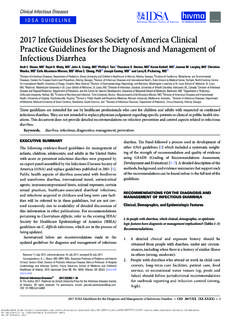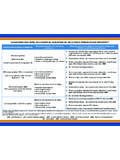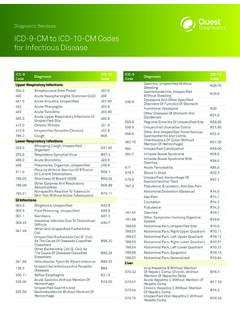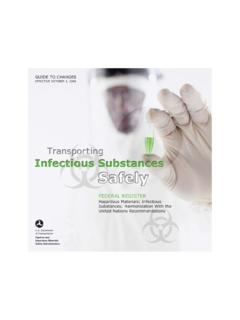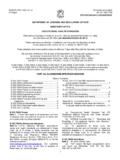Transcription of Guidelines for the Safe Transport of Infectious …
1 world health ORGANIZATIOND ivision of Emerging and Other CommunicableDiseases Surveillance and ControlGuidelines forthe safe Transport ofInfectious Substancesand Diagnostic SpecimensWHO/ : GeneralOrig.: English world health organization , 1997 This document is not a formal publication of theWorld health organization (WHO), and all rights are reservedby the organization . The document may, however, be freely reviewed,abstracted, reproduced and translated, in part or in whole,but not for sale nor for use in conjunction with commercial document was prepared by the Directorsof WHO Collaborating Centres for Biosafety and other of ContentsIntroduction .. 1 Definitions .. 2 Infectious Substances .. 2 Diagnostic Specimens .. 2 Packaging, Labelling and Documentation for Transport .. 3 Basic Triple Packaging System .. 3 Requirements for Infectious Substances .. 5 Requirements for Diagnostic Specimens .. 9 Requirements for Air Mail .. 10 Refrigerants .. 10 Local Surface Transport .. 11 Transport Planning.
2 12i1 WHO/ Transport of Infectious SubstancesIntroductionThese Guidelines are applicable to the Transport of Infectious substances anddiagnostic specimens both nationally and internationally. They provideinformation for identifying and classifying the material to be transported andfor its safe packaging and Transport . The Guidelines stress the importance ofdeveloping a working relationship between the groups involved the sender,the carrier and the receiver in order to provide for the safe and expeditioustransport of this , airline and other Transport industry personnel hold concerns about thepossibility of their becoming infected as the result of exposure to infectiousmicroorganisms that may escape from broken, leaking or improperly packagedmaterial. The packaging of Infectious materials for Transport must thereforeaddress these concerns and be designed to minimise the potential for damageduring Transport . In addition, the packaging will serve to ensure the integrity ofthe materials and timely processing of are no recorded cases of illness attributable to the release of specimensduring Transport , although there are reported incidents of damage to the outerpackaging of properly packaged materials.
3 The shipment of unmarked andunidentified Infectious materials, improperly packaged, obviously increases theoverall potential for exposure to all international regulations for the Transport of Infectious materials by anymode of Transport are based upon the Recommendations of the United NationsCommittee of Experts on the Transport of Dangerous Goods (UN). The UniversalPostal Union (UPU) reflects these recommendations in its regulations,particularly for packaging. The International Civil Aviation organization (ICAO)and the International Air Transport Association (IATA) have also incorporatedthe UN Recommendations in their respective regulations, as have otherinternational Transport organizations. The world health organization servesin an advisory capacity to these bodies. This document provides practicalguidance to facilitate compliance with current international regulations. If, at afuture date, any modification is made in the section of the UN Recommendationson the Transport of Dangerous Goods dealing with Infectious substances anddiagnostic specimens, these Guidelines will be updated Transport of Infectious Substances2 DefinitionsFor the purpose of describing Transport safety measures the terms infectioussubstances and Infectious materials are considered synonymous.
4 The term Infectious substances will be used in this substancesAn Infectious substance is defined as a substance containing a viablemicroorganism, such as a bacterium, virus, rickettsia, parasite or fungus, that isknown or reasonably believed to cause disease in humans or animals*.With respect to packaging and Transport situations, Infectious substances include:1. all cultures containing or suspected of containing an agent which may causeinfection;2. human or animal samples that contain such an agent in quantities sufficientto cause infection, should an exposure to them occur due to a transportmishap;3. sample(s) from a patient with a serious disease of unknown cause;4. other specimens not included above and designated as Infectious by aqualified person, a physician, scientist, nurse, etc.*This definition is taken from the current UN Recommendations on theTransport of Dangerous Goods. Prions are not included in this definitionalthough they are considered to be Infectious specimensA diagnostic specimen is defined as any human or animal material including,but not limited to, excreta, blood and its components, tissue and tissue fluidscollected for the purposes of diagnosis, but excluding live infected specimens resulting from medical practice and research are considered anegligible threat to the public Transport of Infectious SubstancesDiagnostic specimens obtained from patients with suspected Infectious diseasesmay contain limited quantities of an Infectious agent.
5 There are very few agentswhich may be the source of an infection as a result of a Transport mishap. Ifexposure to the specimen due to Transport mishap could result in an infection, thediagnostic specimen must be packaged, labelled and transported as an infectioussubstance. Diagnostic specimens collected during an investigation of an outbreakof a serious disease of unknown cause must be handled as Infectious , Labelling andDocumentation for TransportBecause of the distinction of risks between Infectious substances and diagnosticspecimens, there are variations to the packaging, labelling and documentationrequirements. The packaging requirements are determined by the UN and arecontained in ICAO and IATA regulations in the form of Packaging Instructions(PI) 602 and 650. The requirements are subject to change and upgrade by theseorganisations. The current packaging requirements are described below. UN-approved packaging systems are available triple packaging systemThe system consists of three layers as Primary receptacle.
6 A labelled primary watertight, leak-proof receptaclecontaining the specimen. The receptacle is wrapped in enough absorbentmaterial to absorb all fluid in case of Secondary receptacle. A second durable, watertight, leak-proof receptacleto enclose and protect the primary receptacle(s). Several wrapped primaryreceptacles may be placed in one secondary receptacle. Sufficient additionalabsorbent material must be used to cushion multiple primary Outer shipping package. The secondary receptacle is placed in an outershipping package which protects it and its contents from outside influencessuch as physical damage and water while in data forms, letters and other types of information that identify ordescribe the specimen and also identify the shipper and receiver should be tapedto the outside of the secondary Transport of Infectious Substances4 Figure 1 Triple packaging system5 WHO/ Transport of Infectious Substancesexample:4H /Class packaging marking consists of:(the United Nations packaging symbol(type of packing(the text Class (the last two digits of the year of manufacture of thepackaging(State authority(manufacturer s for Infectious substancesThe basic triple packaging system is used with the following additionalspecifications and labelling and documentation substances may only be transported in packaging which meets theUN class specifications and packaging instruction (PI)602.))))))
7 This ensures thatstrict performance tests which include a nine metre drop test and a puncturetest have been met. The outer shipping package must bear the UN PackagingSpecification Marking (Figure 2). UN-approved packaging supplier listings maybe obtained from carriers or from the appropriate national ministry ordepartment, the Ministry of Transport , 2 Packaging Specification MarkingWHO/ Transport of Infectious Substances6 Hand carriage of Infectious substances is strictly prohibited by international aircarriers, as is the use of diplomatic pouches for that maximum net quantity of Infectious substances which can be contained inan outer shipping package is 50 mL or 50g if Transport is by passenger , the limit per package is 4L-4Kg for Transport by cargo aircraft orother carriers. Primary receptacles exceeding 50 mL in combination packingmust be oriented so the closures are upward, and labels (arrows) indicating the UP direction must be placed on two opposite sides of the package.
8 Thepassenger aircraft quantify limits do not apply to blood or blood products forwhich there is no reason to believe they contain Infectious substances, when inreceptacles of not more than 500 mL each and with a total volume of not morethan 4L in the outer labels for dangerous goodsFor all dangerous goods to be shipped by airfreight, specific hazard label(s)must be affixed to the outside of each package. The following hazards labels areof importance for culture collections or other institutions shipping labels for Infectious substances and forgenetically modified microorganisms which meetthe IATA definition of an Infectious substance :Name: Infectious SubstanceMinimum dimensions:100 x 100 mmFor small packages:50 x 50 mm (black andwhite)Figure 37 WHO/ Transport of Infectious SubstancesHazard label for noninfectious genetically modifiedmicroorganisms and for carbon dioxide, solid (dry ice):Name:MiscellaneousMinimum dimensions:100 x 100 mmFor small packages:50 x 50 mm (black andwhite)Hazard label for liquid nitrogen:Name:Non-flammable gasMinimum dimensions:100 x 100 mmFor small packages:50 x 50 mm(green and white)Packages containing liquid cultures of Infectious organisms and geneticallymodified microorganisms must be packed so that the closure(s) of the innerpackaging(s) are upward.
9 The upright position of the packaging must be indicatedby two Package Orientation labels (black or red arrows). The labels must beaffixed on opposite sides of the packaging. A label THIS SIDE UP or THISEND UP may also be displayed on the top cover of the package:Name:Package OrientationMinimum dimensions:74 x 105 mm(black or red and white)For small packages of Infectious substancesdimensions may be case shipments include only freeze-dried cultures the quantity should begiven in g or mg. not in ml. The PACKAGE ORIENTATION labels should beaffixed to avoid any Transport of Infectious Substances8 Labelling of the outer package for shipment of Infectious substances must includethe elements listed The International Infectious substance An address label with the following information: the receiver s (consignee) name, address and telephone number the shipper s (consignor) name, address and telephone number the UN shipping name ( Infectious Substances Affecting Humans orAnimals as the case may be) followed by the scientific name of thesubstance the UN Number (Humans UN2814, Animals UN2900) temperature storage requirements (optional).
10 If the outer package is further packed in an overpack (with dry ice for instance)both outerpack and overpack must carry the above information, and theoverpack must have a label stating INNER PACKAGES COMPLY WITHPRESCRIBED SPECIFICATIONS .3. Required shipping documents these are obtained from the carrier and arefixed to the outer package: the shipper s Declaration of Dangerous Goods (Figure 4 is one example) a packing list/proforma invoice which includes the receiver s address,the number of packages, detail of contents, weight, value (note: state thatthere is no commercial value as the items are supplied free of charge) An airwaybill if shipping by An import and/or export permit and/or declaration if If the outer package contains primary receptacles exceeding 50 mL incombination at least two Orientation Labels (arrows) must be placed onopposite sides of the package showing correct orientation of the Transport of Infectious SubstancesRequirements for diagnostic specimensThe basic triple packaging system is used with the following specifications andlabelling specimens may be transported in packaging which meets thepackaging instruction (PI)650.











